Existence and Global Stability of a Periodic Solution for Discrete-Time Cellular Neural Networks
Abstract
A novel sufficient condition is developed to obtain the discrete-time analogues of cellular neural network (CNN) with periodic coefficients in the three-dimensional space. Existence and global stability of a periodic solution for the discrete-time cellular neural network (DT-CNN) are analysed by utilizing continuation theorem of coincidence degree theory and Lyapunov stability theory, respectively. In addition, an illustrative numerical example is presented to verify the effectiveness of the proposed results.
1. Introduction
A large number of cellular neural networks (CNNs) models have appeared in the literature [2–4], and these models differ in cell complexity, parameterization, cell dynamics, and network topology. Various generalizations of cellular neural networks have attracted attention of scientific community due to their promising potential for tasks of classification, associative memory, parallel computation [5–9], pattern recognition, computer vision, and solving any optimization problem [10–13]. Such applications rely on the existence of equilibrium points and the qualitative properties of cellular neural networks.
Discrete-time cellular neural networks (DT-CNNs) have been studied both in theory and applications. Previous results introduced many properties of DT-CNN in the two dimensional plane. For instance, [14] has been successfully applied to investigate the discrete-time analogues of cellular neural network (CNN) with variable coefficients in the two-dimensional plane. However, three-dimensional structure is more accurate, specific, and closer to real structures of CNN. Based on the above discussion, this paper proposes some effective results of DT-CNN in the three-dimensional space.
Then, the spatial structure with respect to (1.3) is shown in Figure 1, where , Ω≜{x ∈ 𝒳 ⊂ Nr(ijh), ∥x∥ < Θ}, Nr(ijh) is the r-neighbourhood of a cell , and Θ will be denoted by the proof of Theorem 3.1 in Section 3.
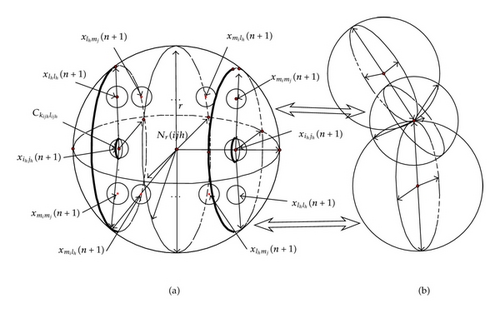
The rest of the paper is organized as follows: in Section 2, system description and preliminaries are developed in detail and some definitions, assumptions, and lemmas are stated. Section 3 gives sufficient conditions for a periodic solution for DT-CNN in three-dimensional space by utilizing continuation theorem of coincidence degree theory. Section 4 proposes global stability of a periodic solution for the DT-CNN. A numerical simulation is given to show correctness of our analysis in Section 5 and concluded in Section 6.
2. System Preliminaries and Description
Throughout the paper, the following definitions and lemmas will be introduced.
Definition 2.1 (Fredholm operator). Let 𝒳 and 𝒴 be a Banach space, an operator L is called Fredholm operator if L is a bounded linear operator between 𝒳 and 𝒴 whose kernel and cokernel are finite-dimensional and whose range is closed. Equivalently, an operator L : 𝒳 → 𝒴 is Fredholm if it is invertible modulo compact operator, that is, if there exists a bounded linear operator S : 𝒴 → 𝒳 such that Id𝒳 − SL, Id𝒴 − LS are compact operators on 𝒳 and 𝒴, respectively, where Id𝒳 and Id𝒴 are the identity operator.
Definition 2.2 (L-compact). An operator N will be called L-compact on if the open bounded set is bounded and is compact, where Kp is the inverse operator of N. Since Im Q is isomorphic to Ker L, there exists an isomorphism J : Im Q → Ker L.
In other words, L|Dom L∩Ker P : Dom L∩Ker P → Im L is invertible, and the inverse of the operator L is denoted by Kp.
Lemma 2.3 (Gaines and Mawhin [15]). Let 𝒳 be a Banach space, L be a Fredholm operator of index zero, and let be L-compact on , where Ω is an open bounded set, suppose:
Lemma 2.4. If a and b are some certain nonnegative vectors, then there exists a positive constant β, such that ab ≤ (β/2)a2 + (1/2β)b2.
Proof. Assuming a and b are some certain non-negative vectors, β is a positive constant, then
Assumption 2.5. ) are N-periodic sequence of . For the sake of convenience, we use the following notations: . For each operator P : Nr(ijh) → Nr(ijh) and any s = s(u, v, w), t = t(i, j, h) ∈ Nr(ijh), such that:
Assumption 2.6. There is a positive constant , such that , for all x1 ≠ x2 ∈ R.
3. Existence of a Periodic Solution with respect to (2.1)
In many cases, many proposed results are not ideal and therefore it is necessary to formulate a novel and effective result for DT-CNN in the three-dimensional space. Can we obtain the result about the existence and stability of a periodic solution for DT-CNN in three-dimensional space? This is the topic we wish to address in this paper. The aim of the present work is to develop a strategy to determine the existence and global stability of a periodic solution with respect to (2.1) in the three-dimensional space. Consequently, we processed with the following result.
Theorem 3.1. Suppose that Assumptions 2.5 and 2.6 hold, and the following condition holds:
Proof. In this section, by means of using Mawhin’s continuation theorem of coincidence degree theory, we will study the existence of at least one periodic solution with respect to (2.1), for convenience, some following notations will be used:
Set
Obviously, employing the Lebesgue’s convergence theorem, we can easily learn that is bounded, is compact for any open bounded set Ω ⊂ 𝒳⊂Nr(ijh) by using Ascoli-Arzela’s theorem (A subset ℱ of 𝒞(𝒳) is compact if and only if it is closed, bounded and equi-continuous). Thus, N is L-compact on a closed set with any open bounded set Ω ⊂ 𝒳 ⊂ Nr(ijh).
Suppose that is a solution with respect to (2.1), for certain λ ∈ (0,1). Then the following equation can be derived by (2.2):
Then, the following results can be derived by utilizing (3.7):
Then the open bounded set Ω is presented as follows:
Thus Lx ≠ λNx for any (x, λ)∈(∂Ω∩Dom L)×(0,1), the Ω satisfies condition (i) in Lemma 2.3.
In Figure 2, the nonlinear weights template matrices B and the boundary of Ω are shown, respectively. Then for any two dimensional plane of any spherical neighbourhood is denoted. Thus, for any , , it is easy to learn that x is a constant vector in with ∥x∥ = Θ; Thus, we have
In order to prove the condition (iii) is satisfied with respect to (2.1), we only need to prove that deg (JQN, Ω∩Ker L, 0) ≠ 0. Define Φ : Dom L → 𝒳 by
Now we will prove that , ≠ (0,0,…,0)T. If this is not true, then , , thus, for constant vector x ∈ ∂Ω, we have:
Equivalently, (3.14) can be written as the following form:
Combining (3.12) and (3.15), the following results are obtained:
Thus, the following result is derived by calculating the (3.16):
Obviously, (3.17) is a contradiction since ((1 + β(h))/β(h)) > 1, then for any x = ∂Ω∩Ker L, Ker L = Im P, , . Thus, deg (JQN, Ω ∩ Ker L, 0) ≠ 0. Therefore, (2.1) has at least one N-periodic solution, thus the proof of Theorem 3.1 is completed.
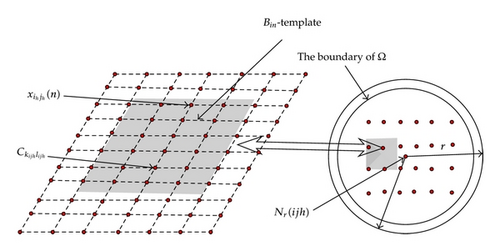
Corollary 3.2. Suppose that Assumptions 2.5 and 2.6 hold, and the following condition holds:
Proof. Similar to the proof of Theorem 3.1, so it is omitted.
4. Globally Stability of a Periodic Solution with respect to (2.1)
The existence of a periodic solution for the system (2.1) is derived in the Theorem 3.1. Then global stability of a periodic solution with respect to (2.1) in the three-dimensional space is presented in the following.
Theorem 4.1. Suppose that Assumptions 2.5 and 2.6 hold, and the following condition holds:
Proof. It follows from the Theorem 3.1 that (2.1) has at least a periodic solution, without loss of generality, the periodic solution can be described by:
Then we can define the following formula:
Now, we show that the a periodic solution x*[n] is globally stable, and the following inequality is obtained by utilizing (2.1) and (4.3):
We design the following Lyapunov-type sequence V[n] by
Then, we can calculate the ΔV[n] by combining (2.1) and (4.5):
Thus, it is easy to obtain V[n] ≤ V[0] by the meaning of the (4.6), and furthermore,
5. Numerical Simulation
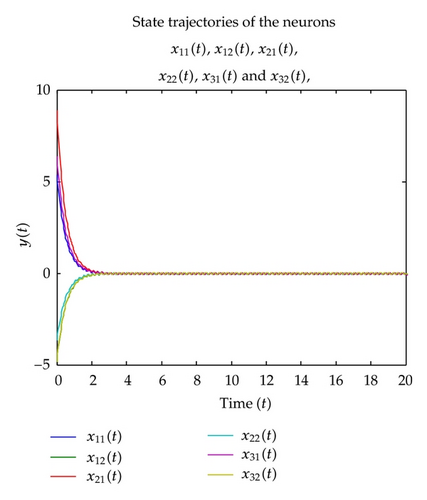
(2) We will verify the condition of Theorem 3.1 if we want to utilize Theorem 4.1. After strictly calculating the condition of Theorem 3.1, it is easy to obtain that the function , i = 1,2, 3, j = 1, 2, n ∈ IN; therefore, the condition of the Theorem 3.1 is critically satisfied as well.
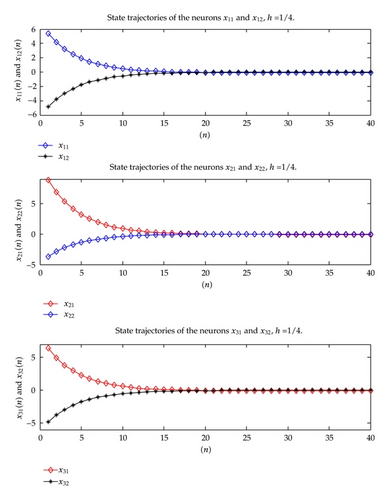
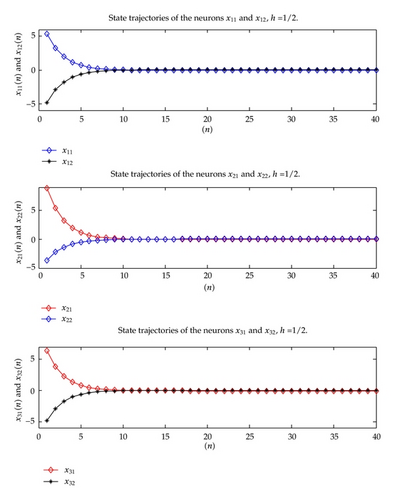
From Figures 4 and 5, we can learn that all the periodic solution converges to a unique a 1/4h-periodic solution, then the DT-CNN (2.1) has a globally stable 1/4h-periodic solution. Thus, all conditions of Theorems 3.1 and 4.1 are strictly satisfied; therefore all conditions of proposed theorems are critically verified.
6. Conclusions
Existence and global stability are important dynamical properties in CNN. In this paper, we consider the discrete-time analogues of CNN with periodic coefficients and obtain some new results for the DT-CNN in the three-dimensional space. Comparisons between our results and the previous results have also been made. And it has been demonstrated that our criteria are more general and effective than those reported in the literature.
Acknowledgments
The authors wish to acknowledge Major Program of National Natural Science Foundation (NNSF) of China under Grants 11190015 and 60875035, Research Fund for the Doctoral Program of Higher Education of China under Grant 20100092110020, and Scientific Research Foundation of Graduate School of Southeast University under Grant YBJJ1215.




